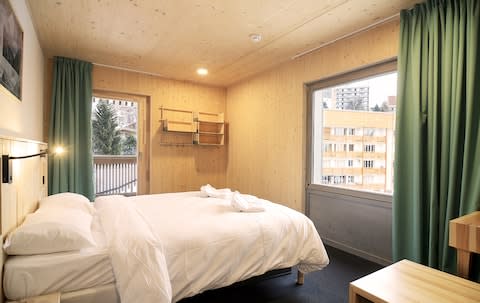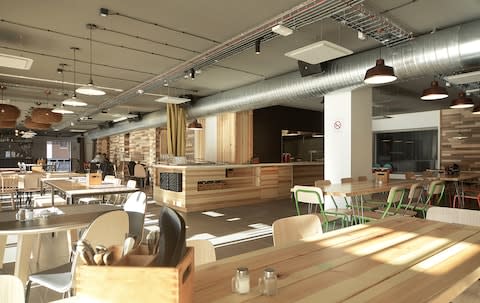How a new-wave of mountain hostels is appealing to skiers on a budget

Back to the future? Well, it’s something like that. Hostels and dormitories, once among the least attractive features of a budget ski-holiday, are returning to some of the resorts most favoured by British skiers.
New hostels are also popping up in more surprising places: western Canada, for example, has seen the advent of two this season, one in Whistler and another in nearby Sun Peaks. But it is the French Alps that have proved the most fertile ski terrain for this kind of accommodation. Two hostels opened in 2016 (at Alpe d’Huez and Les Houches, near Chamonix) and another in 2017 (at Les Menuires); two more followed this season (at La Plagne and Les 2 Alpes).
These new-generation French hostels have a lot in common. First, they are nothing like the old generation: nobody has to hang blankets around their bed to get some privacy, as guests sometimes did on pre-war Erna Low holidays. Even guests in bunk beds now get privacy, a lockable cabinet, and a socket for charging their digital devices. Second, the hostels are creatively designed and decorated; they are aimed at a youthful clientele, and it shows. Third, they offer excellent value.
Characteristically, the hostels provide a range of accommodation from bunks in large or small dormitories to family rooms; some also have suites, and others even apartments. Like EasyJet ticket prices, the room rates are flexible, responding to supply and demand; but the spread of prices is much narrower than that allowed by airlines.
At the new People Hostel in Les 2 Alpes, where I stayed in January, the lowest price for a night in a bunk in an eight-person dormitory was €19. The highest price was €41. A double room cost from €59 to €159.

Where does the origin of this new type of budget hospitality lie? Primarily, in backpacker culture. The growth of low-cost flying after the millennium prompted a mass wanderlust and a huge demand for cheap beds; that led to backpacker booking sites such as Hostelworld, which lists 36,000 properties in 170 countries.
One of the big UK-based backpacker chains is St Christopher’s Inns, which has beds from £9 per night in 10 countries. Four years ago, the director of the group’s Paris hostel was a man named Romain Viennois. Now, at the age of 40, he has created the People Hostel in Les 2 Alpes, and another property in Lille; in the next two years, four more People Hostels will follow, part-financed – indirectly – by the French government as part of an initiative to increase the country’s stock of guest beds.
The Les 2 Alpes property is prominently located at the entrance to the resort, not far from the ski lifts. Its shape resembles that of an upright, half-open book, the two wings of the building – one brand new, the other a conversion – enclosing a small wedge of open space. It’s efficient design makes the building seem much too small to contain the claimed 364 beds – and actually, it doesn’t. Viennois explained with a smile that it actually has only 362 ‘because we forgot to put a luggage room on the plan’.
It is axiomatic that backpacker hostel rooms are too small. Rather than spending time in a bedroom, any young traveller who is not actually asleep should be exploring, experiencing, or at least socialising in the hostel bar: that is part of the business model. In the evolution from backpacker properties to new-generation hostels that philosophy has been eroded, but not erased.

By backpacker standards, the People Hostel’s rooms are … well, roomy. But when two guests move around a double room at the same time, they must do so in unusual harmony. The hostel’s rooms are, however, much more polished than I expected, dressed in charcoal and white, with pine panels; there is a welcome selection of clutter spaces, including an imaginative shallow loft above the door; and in my shower room was a splendid mirror, hovering just off the wall, backlit by a mass of LEDs, with a frame of frosted glass and a little heat source to prevent steaming-up.
Apart from the stairwells, whose chicken-wire and silver paint suggesting an imminent revival of West Side Story, the public areas are business-like, from the reception area with its three DIY check-in keyboards through the bar (a beer or wine from €3.50) to the very-good-value restaurant (breakfast from €4, dinner from €12). The large chill-out area in the basement lacked atmosphere, but that was my fault: go to the Alps in mid-January and you must expect quiet resorts.
Les Menuires, my next destination, was more animated; but its new-generation hostel, opened last season, had none of the presence of the People Hostel. In fact, Ho 36 had no presence at all. I drove up and down past the large hut occupying the spot where I thought Ho 36 should be until, luckily, somebody came out and flagged me down.
If the People Hostel’s trick of hiding 362 beds was an architectural illusion, the Ho 36 seemed to be a tardis.
The truth is that most of the hostel’s 150 beds are located out of sight from the front of the building: the ground drops away sharply behind it, so only the few suites and apartments above the entrance are visible. The other floors step down the back of the building. By which happy accident guests may take the lift to the basement-level boot room and ski out of the back door.
Frank Delafon, owner of the Ho 36 hostels in La Plagne and Les Menuires, plus similar urban properties in Lyon and Avignon, was a restaurateur in Lyon when he took a six-month sabbatical with his family, travelling on the west coast of the Americas. The experience of travelling with three young children led him, on their return, to become a ‘hostelier’ as well. The success of the first H036 property was such that in his early forties he could finance a small chain of hostels.

His Les Menuires property, built on the base of a former hotel, is a marvelous creation. A 30-yard-long flagstone floor stretches almost the length of the building’s reception level; it is furnished with tables of various shapes and sizes, and a similarly eclectic stack of chairs, some apparently hewn from a tree.
Everything that happens in the hostel happens here, in this relaxing space: drinking (beer from €2.80, wine €3.50); meeting the owner; dining (mains, about €15); paying the bill (in January the lowest price in a 14-bed shared room was €20, highest €22, double rooms from €103 to €189); tasting the chef’s first, triumphant banoffee pie; digesting.
Downstairs the Trois Vallees, the world’s biggest and best ski area, awaits the day. Is there anything that could improve this place? Yes: just slightly bigger rooms.
Need to know
The People Hostel in Les 2 Alpes offers a bed in dorm style rooms from €19. The equivalent in Ho 36, Les Menuires start from €20.


